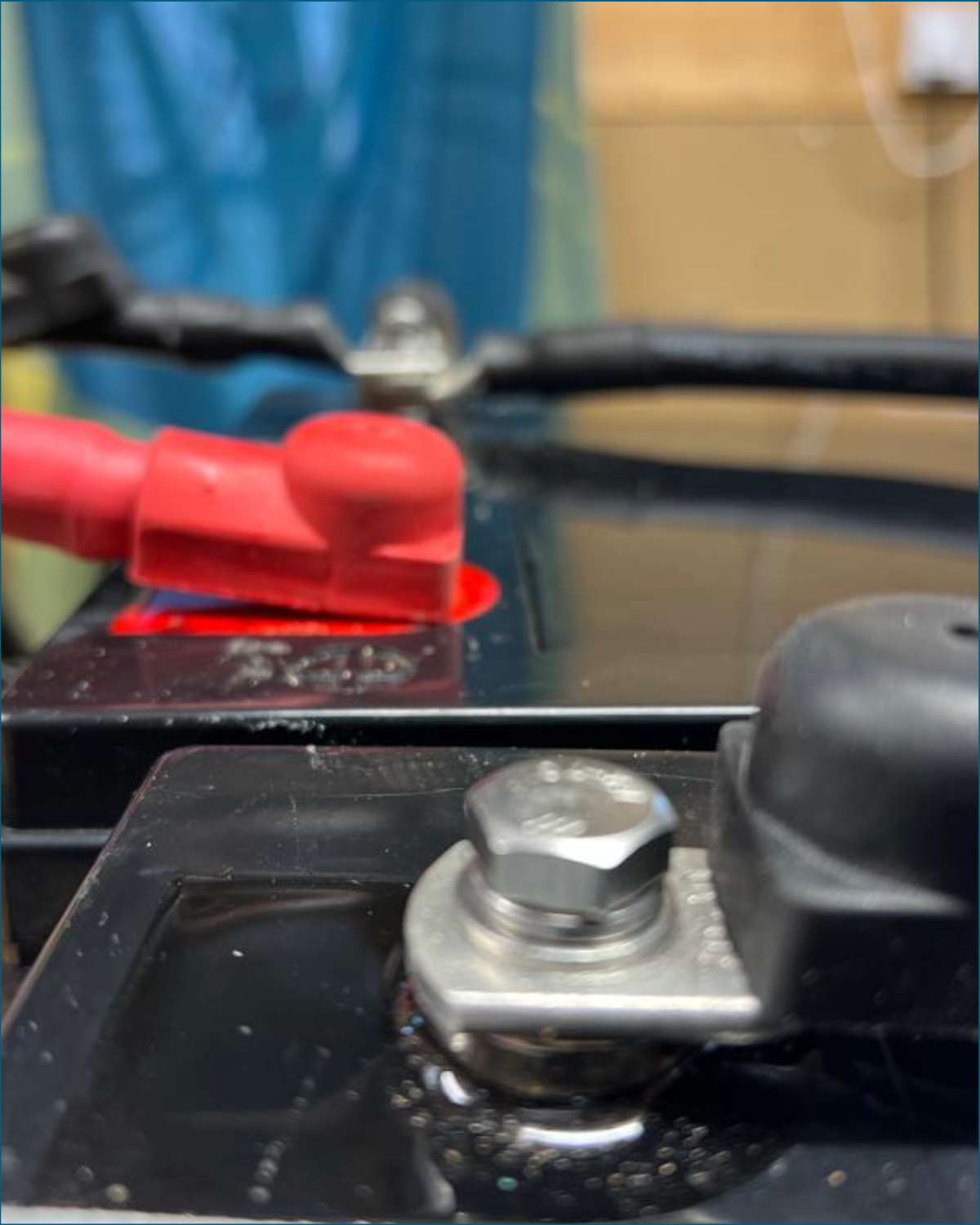Struggling with solar panel setup? Dive into our comprehensive guide on solar panel series vs parallel connections. We shed light on both options, enabling you to decide the best fit for your solar energy needs.
The setup or configuration of solar panels plays a crucial role in determining how efficiently we can convert solar energy into electricity.
There are two primary ways in which solar panels can be configured: series and parallel.
Solar panels are linked one after the other in a series configuration, much like a daisy chain.
This setup increases the voltage, allowing the system to deliver consistent energy even under less-than-ideal light conditions.
On the other hand, in a parallel configuration, solar panels are connected side by side.
This setup increases the current, helping the system to produce more power when there’s plenty of sunlight.
Understanding the difference between these configurations, their advantages and disadvantages, and when to use each can help us to make the most efficient use of solar energy.
It can also guide us in designing tailor-made solar systems to suit our specific needs and conditions.
In this article, we’ll delve deeper into these configurations, unraveling their intricacies and helping you understand how to harness the sun’s power most effectively.
At a Glance: Solar Panel Series vs Parallel Connections
- Solar panel wiring involves connecting panels in series or parallel to optimize power output and efficiency.
- Series connections increase voltage, while parallel connections keep voltage constant and limit the impact of shading.
- The best configuration for a solar power system depends on current requirements, shade levels, compatibility & efficiency factors.
Here’s a simple table that highlights the differences between wiring solar panels in series and parallel:
Solar Panels Wired in Series
- Voltage – Increases with each panel
- Current – Remains constant across panels
- Performance in Shading – Lower performance as one shaded panel affects the entire string
- Panel Specifications – Ideal for identical panels
- Installation – Easy & low cost
- Charge controller – larger MPPT controller needed
- Entire solar array is affected if one panel is damaged or in shade
- Can charge battery for more hours each day
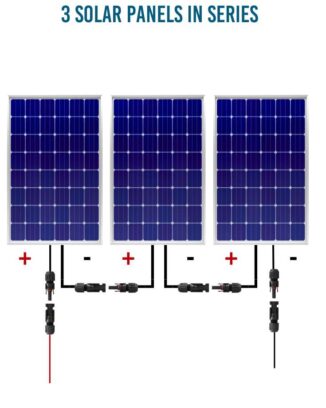
Solar Panels Wired in Parallel
- Voltage – Remains constant across panels
- Current – Increases with each panel
- Performance in Shading – Better performance as the shaded panel does not drastically affect others
- Panel Specifications – Works with mixed panels
- Installation – More complex & higher cost
- Charge controller – smaller size than in series
- Solar array continues to perform if a single panel is damaged
- Less charging time during the day
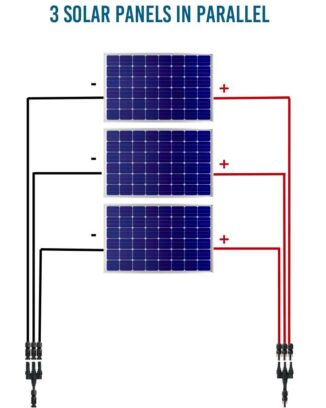
Solar Panels Series vs Parallel Configurations: The Basics
The way these solar panels are arranged can have a significant impact on their performance.
The arrangement or configuration of solar panels is a critical factor in determining how efficiently they can convert solar energy into electricity.
There are two main ways to set up these panels: in series or parallel.
In a series configuration, the solar panels are connected in a line, one after the other.
Setting up solar panels in a series means connecting the positive terminal of one panel to the negative terminal of another.
This setup boosts the voltage, but the current remains unchanged.
On the flip side, in a parallel configuration, multiple solar panels are connected side by side.
When you connect solar panels in parallel, you connect all the positive terminals and all the negative terminals.
This setup boosts the current while the voltage remains unchanged.
Understanding these concepts and the differences between series and parallel configurations can help us maximize solar energy.
It can guide us in designing a system ideally suited to our needs and circumstances.
An efficient solar power system requires a balance between voltage for consistent battery charging and minimal overall power output loss.
Solar Panels in Series Configuration
When you wire multiple solar panels in a series configuration, it involves connecting the positive terminal of one panel to the negative terminal of the next.
This forms a series circuit.
The outcome? Your array’s voltage gets a boost while the current stays constant.
Consider this example: if you wire four 100W panels (each with a rated voltage of 17.9V and current of 5.72A) in series, the result is an output of 71.6 volts (17.9V x 4) and 5.72 amps.
This gives you an overall power output of 409 watts.
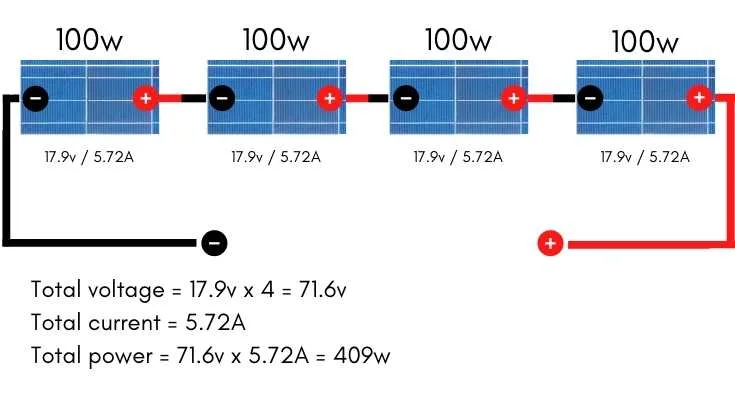
However, remember that these wattage ratings are determined under standard test conditions.
Real-world factors such as shade and temperature can cause these numbers to fluctuate.
Connecting solar panels in a series is popular, but it has good and not-so-good points.
It depends on what you’re looking for and your specific situation.
Getting a handle on these pros and cons is important before you decide.
If you don’t pick the right method, it could mess with the energy you can generate when you’re out there boondocking and relying on your batteries.
Advantages of Wiring Solar Panels in Series
Here are the main advantages of wiring your RV solar panels in series compared to a parallel configuration:
Long-lasting Battery Charge
When you wire solar panels in series, your RV batteries can charge longer than in parallel.
This is because series wiring boosts the voltage output, allowing your batteries to charge even when sunlight is low.
This means even in less-than-ideal sunlight conditions, you can still get the necessary voltage to recharge your battery.
So, when you wire solar panels in series, the battery can begin charging early and later in the day.
Easier & Cheaper Installation
Installing solar panels in series is pretty straightforward and less complicated than parallel wiring.
You’ll deal with fewer wires, making the setup quicker and easier.
Wiring in series also means using less cable and fewer MC4 connectors. Plus, you can use smaller wire sizes because they don’t need to cope with high currents.
So you’ll save some bucks compared to a parallel connection.
Disadvantages of Solar Panels Wired in Series
It’s also crucial to be aware of the potential downsides of wiring solar panels in series. Let’s delve into the main issues you might encounter.
Shading
When solar panels are wired in series, if one panel gets shaded, it affects the performance of the entire array.
You must be mindful of where you park to avoid shading your solar panels.
Single Point of Failure
If a single solar panel in a series is damaged, it can reduce the efficiency and power output of the entire array.
Regular inspections and prompt repairs are key to maintaining your system’s performance.
Need for a Larger Charge Controller
Wiring solar panels in series usually requires a larger MPPT charge controller.
This can add to the cost and complexity of your solar setup.
Smaller Limit on Maximum Power
While needing a larger MPPT controller for series wiring is a disadvantage, it becomes more complicated if you have numerous solar panels.
For instance, Renogy’s Rover 100 Amp MPPT solar charge controller can cater to up to 150 volts and 100A.
This means it can accommodate up to six 100W solar panels wired in series but up to 20 when wired in parallel!
Most RV users might not have the luxury of fitting more than six solar panels on their campers, but this limitation could be an issue for those who do.
You can overcome it by using multiple solar charge controllers or by wiring your panels in a combination of series and parallel configurations, which we’ll discuss in a different post.
Solar Panels Wired in Parallel
When configuring solar panels in parallel, you’ll connect all the positive terminals of the panels and, likewise, all the negative terminals.
The key characteristic of a parallel configuration is that it amplifies the current while keeping the voltage constant.

For example, if you connect four 100W panels, each having a rated voltage of 17.9V and a current of 5.72A, your system will generate a steady 17.9 volts, but the current will increase to 22.8 amps (5.72A x 4).
This results in a total power output of 409 watts.
However, it’s essential to remember that the wattage of solar panels is calculated under standard test conditions, which may not always reflect real-world circumstances.
Factors such as temperature fluctuations and shading can affect the actual power output.
Advantages of a Parallel Configuration
Here are the main advantages of wiring your RV solar panels in parallel:
Reduced Impact from Shading or Damage
In a parallel setup, each panel connects to the same wires independently. This means that the other panels remain unaffected if one panel is shaded or damaged.
The system won’t suffer a significant drop in output or efficiency due to an underperforming panel.
Easy Replacement of Damaged Panels
If a panel gets damaged in a parallel array, it’s pretty straightforward to remove and replace it.
You can disconnect the faulty panel without having to rewire the entire system, making maintenance easier.
Plus, it’s easy to add more solar panels in the future.
Efficiency with Mixed Panels
When installing solar panels, it’s more efficient if all panels have identical specifications.
However, a parallel configuration can help minimize power loss compared to a series configuration if you have different panels.
For example, two 130W panels and a 90W panel wired in parallel can deliver a higher wattage with only a 2% loss, while they’d lose 29% if wired in series.
Smaller MPPT Controller Required
The MPPT (Maximum Power Point Tracking) controller needs to handle the combined output of all the panels.
When panels are wired in parallel, the voltage remains low, and the current increases, meaning you can use a smaller, less expensive MPPT controller.
For example, if you connect six 100W panels in parallel, you’d need an affordable Rover 40 Amp MPPT Controller, which costs around $150.
However, if these same panels were wired in series, you’d require a larger Rover 60 Amp Controller that costs about $300.
This demonstrates the cost savings you can achieve with parallel wiring.
Disadvantages of a Parallel Configuration
Wiring solar panels in parallel comes with its set of challenges:
Less Charging Time
Parallel wiring may not offer enough voltage to charge a battery throughout the day.
A battery needs a minimum of 12.6 volts for proper charging, but the output might be lower, especially during mornings and evenings when sunlight is minimal.
Some solar charge controllers need an input voltage higher than the battery’s, which parallel wiring might not provide.
In contrast, series wiring can generate higher voltages, extending battery charging time.
Complex Wiring
Installing solar panels in parallel tends to be more complex due to the need for branch connectors.
The more panels there are, the more connectors you’ll need, complicating the installation process.
This complexity could also pose problems for future troubleshooting.
More Wire & Connectors Needed
Parallel wiring requires more cables than series wiring since panels aren’t connected end-to-end.
You’ll likely need cable extensions for some panels, increasing costs.
Parallel wiring needs extra cable connectors, which adds to your budget.
Every panel must connect to two branch MC4 connectors—one for positive and one for negative cables—requiring additional MC4 connectors to join the solar charge controller.
For instance, wiring four panels in parallel could cost around $80 in connectors alone.
Greater Current
Wire size, determined by circuit length and current rating, is crucial for the safe operation of RV solar systems.
In parallel wiring, the current rating is higher than in series, potentially requiring thicker wires to avoid overheating or fire hazards.
Is It Better to Wire Solar Panels in Series or Parallel?
This is a tricky question since there’s no definitive answer—both configurations have advantages and disadvantages.
And even then, your location and energy use can affect which configuration is better.
Choosing the best configuration for your solar panel system hinges on factors like shading and battery charging capacity.
In general, series connections are better suited for unshaded areas and systems with low amperage requirements due to their higher voltage output and faster charging times.
On the other hand, parallel connections are more efficient in shaded areas and systems with low voltage requirements, as they provide increased current without impacting voltage.
But you need to look at the bigger picture here. What are we trying to achieve?
We live in our RV full-time and rarely hook up to shore power, so we aim to generate power to maximize our battery charging.
Let’s consider three main factors:
- Math
- Shade
- Battery Charging
Math
Assuming all solar panels in the array are identical, the maximum total power output under optimum operating conditions is the same.
But the current and voltage differ, depending on whether they’re wired in series or parallel.
Power = Voltage x Amps
If we have two panels, each with 20V and 5A:
In series, voltage is combined while the current remains constant, so:
(2 x 20V) x 5A = 40V x 5A = 200W
In parallel, the current is combined while the voltage remains constant, so:
20V x (2 x 5A) = 20V x 10A = 200W
Shade
The amount of energy produced by solar panels fluctuates throughout the day and over different seasons, largely due to the sun’s changing position in the sky.
The impact of clouds and shade on solar panels shouldn’t be overlooked.
The energy your solar panels produce changes during the day and across seasons.
If you have an RV or camper, parking in the shade matters a lot.
If your panels are wired in parallel, and shade hits one of them, only that panel’s power drops. The rest keep working fine.
But if your panels are wired in series, it’s a different story.
Not only does that shaded panel’s power drop, but it also pulls down the power of all the other panels in the line.
So, where you park matters!
Battery Charging
It might initially seem that a parallel configuration is superior due to its better performance in partial shade.
However, we must remember that our main objective is to generate power to maximize our battery charging.
A battery needs about 12.6v to charge, and it’s a crucial factor.
Solar panels wired in parallel typically produce a voltage range of 17-22v, assuming optimal environmental conditions.
Any deviation from these conditions can cause the voltage to drop.
For instance, if you have four 100w panels with a rated voltage of 17.9, they could collectively produce 17.9 volts in a parallel configuration or 71.6 volts in series.
Under ideal conditions, both setups produce sufficient voltage to charge the battery bank.
However, in a parallel configuration, the panels must maintain at least 70% performance; otherwise, the voltage will drop below the required 12.6v for charging the battery bank, making them practically ineffective.
In contrast, with a series configuration, the performance would need to plummet to approximately 18% before the panels stop charging the batteries.
Consequently, while both configurations have merits, these considerations are crucial when deciding the most suitable setup for your camper’s solar system.
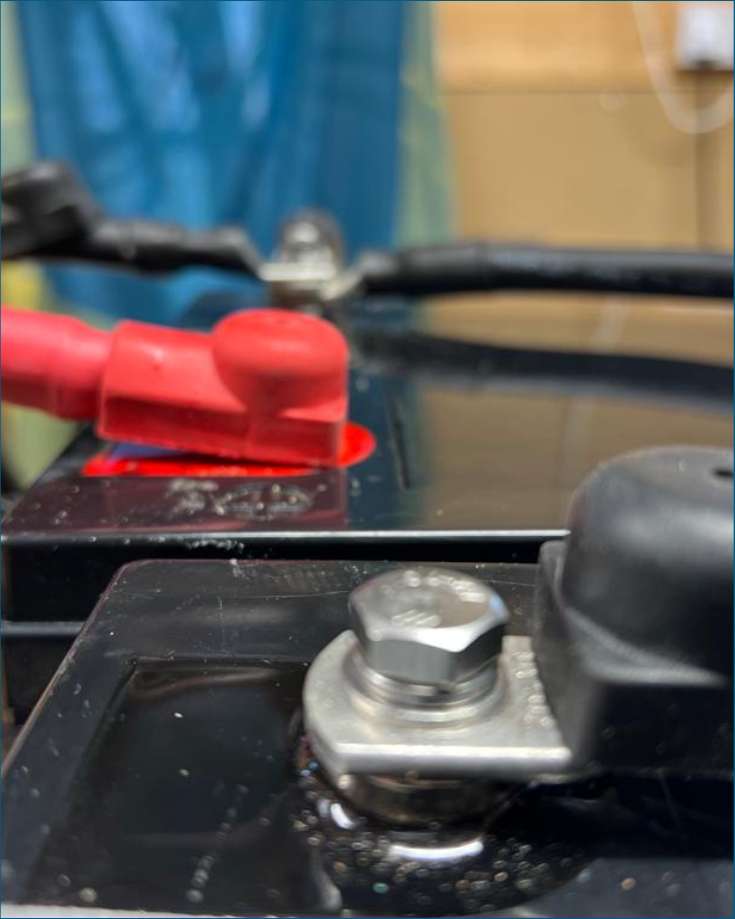
Can I Combine Series and Parallel Connections?
Yes! You can combine series and parallel connections.
This is sometimes called a “hybrid” configuration, which is popular on large RV campers.
It combines the advantages of both series and parallel wiring, such as increased current from parallel wiring with higher voltages from series wiring.
A hybrid wiring configuration is a combination of series and parallel connections that are implemented to increase both voltage and amperage.
This can be advantageous in certain situations, such as:
- Using mismatched solar panels,
- Installing a large solar array,
- Installing multiple panels with different orientations, such as on an Airstream or travel trailer.
Ideal Scenarios for Using a Series Configuration
Here are some scenarios when a series configuration could be the best choice for solar panels:
- Limited Ampacity: If you need to limit the current output so yoru charge controller can handle your solar array, wiring in series can keep the current low while still delivering high power.
- Low Light Conditions: A series configuration can be beneficial in low-light conditions because it can reach the required voltage to charge batteries even when individual panel output is low.
- Matching Panel Specifications: If all your solar panels have the same specifications, series wiring is straightforward and ensures that each panel operates efficiently.
Ideal Scenarios for Using a Parallel Configuration
Here are some scenarios where a parallel configuration might be the best choice for solar panels:
- Handling Shading: Parallel configurations handle shading better than series configurations. If one panel is shaded in a parallel setup, it won’t drastically affect the performance of the other panels.
- Mixed Panel Specifications: If your solar panels have different power ratings or are of different types, wiring them in parallel results in less total power loss than wiring them in series.
- Fault Tolerance: In a parallel configuration, if one panel fails or underperforms, the overall system continues to operate, albeit at reduced capacity. This isn’t necessarily true in a series configuration where one faulty panel can disrupt the entire string.
- Limited Voltage Capacity: If your charge controller has a limited voltage capacity, a parallel configuration can keep the voltage within safe limits while delivering ample power.
In Conclusion
Whether you’re choosing a series, parallel, or a combination of both configurations for your solar panel setup, the decision should be guided by your specific needs and circumstances.
Consider factors such as the specifications of your panels, the conditions of your installation site, and the limitations of your equipment.
Each configuration has its advantages and potential drawbacks.
A series configuration can boost voltage for long-distance transmission and perform well in cold or low-light conditions.
A parallel setup tolerates shading and handles mixed panel specifications more efficiently.
By understanding these aspects, you can make an informed choice that optimizes the performance of your solar power system.
Graham Bogie

Graham is a seasoned marine electrical engineer with two decades of experience designing customized electrical systems for plant machinery and converting campers and overland vehicles. His expertise has led him to author the reputable Campervan Electrics Handbook and become the chief designer of the RV Wiring Design Tool. As a knowledgeable figure in the field, his YouTube channel, blog, Facebook group, and newsletter, offering electrical advice and product reviews, reach more than a million users each year.
Automatically Create Your Bespoke RV Wiring Diagram
Includes 110v & 240v, solar, B2B, batteries, inverters, 12v, 24v & 48v systems, wire gauges in AWG & mm² & much more!



